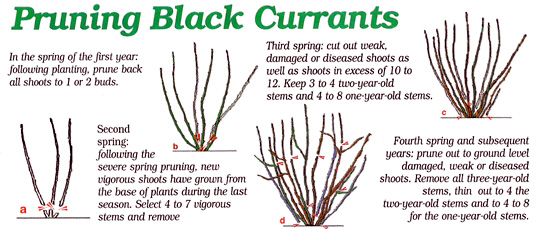| Quantity | Price |
| 1-9 | $11.00 |
| 10-29 | $9.50 |
| 30-99 | $9.00 |
| 100 + | $8.25 |
The erect bush has mildew resistance. The extra-large, red fruit is very early, productive, and easy to pick.

| Quantity | Price |
| 1-9 | $11.00 |
| 10-29 | $9.50 |
| 30-99 | $9.00 |
| 100 + | $8.25 |
The erect bush has mildew resistance. The extra-large, red fruit is very early, productive, and easy to pick.
Hardiness Zone: 3 - 5
ATTENTION: WE CANNOT SHIP TO THE FOLLOWING STATES: AZ, CA, DE, FL, ME, MA, MI, NV, NH, NJ, NM, NY, NC, RI, WV.
A 1941 introduction from Holland.
Currants and gooseberries are a major fruit crop in Europe. Black currant juice is to Europeans as orange juice is to us. They have not been produced widely in the U.S. for many reasons. The major reason being a federal ban on plants as they thought white pine blister rust could be eliminated by eradication of the alternative host (Currants). This was not the case, and the federal ban was lifted, however, local bans are still in effect in some regional areas. Currants and gooseberries are hardy and easy to grow. A few plants will produce enough fruit for typical family use and this fruit is much prized for making jellies and pies.
Currants and gooseberries prefer a cool climate and a rich, moist, well-drained soil high in organic matter. Silt and clay loams are best; however, plants should do well on fertile sandy loams. Light, sandy soils that tend to become hot and dry during the summer, or land where water stands at any time during the year should be avoided. Because both currants and gooseberries blossoms very early in the spring, they should not be planted on lowlands or in pockets where late spring frost may injure blossoms. Your new planting should be made into weed-free, deeply worded soils with pH between 6 and 7.
Attention Michigan customers:
White Pine Blister Rust Control Area Counties
If yor county is not under the control area and wish to order please call us 800-295-2226 to place order over the phone.
Set the plants as early as possible in the spring. Space plants 4 to 5 feet apart in each direction. Remove all damaged or broken roots before planting and cut the tops back to 6 to 10 inches above the ground. Set bareroot plants deep enough so the lowest branch will be just below the soil surface. This is to develop a bush form. Spread the roots well and compact moist topsoil firmly around them. Make sure no fresh manure or commercial fertilizer comes into contact with the roots. You should see new green growth in 2 to 3 weeks.
(1) = Minimum suggested spacing.
Planting Distance *1
Planting Distance *1
Interval from Planting to Fruiting
Full Production
Life of Plants
Height of Mature Plant
Est. Annual Yield
Between Rows (ft)
Between Plants (ft)
Years
Years
Years
Feet
Per Plant
Currants
6-8
4
2
4
12-15
3-4
3-4 qts
Gooseberries
6-8
4
2
4
12-15
3-4
4-5 qts
Apply a 6" layer of mulch of straw, grass clippings, sawdust or peat to control weed growth and maintain moisture. Apply a balanced fertilizer (10-10-10) annually either in the fall after growth stops or early spring before growth begins.
At the end of the first season remove all but 6 or 8 of the most vigorous shoots. At the end of the second season leave 4 or 5 one-year old shoots and 3 or 4 two year canes. At the end of the third year, keep 3 or 4 canes each of 1,2 and 3 year-old wood. This will make a total of 9-12 canes on each plant. Canes 4 year and older produce very little fruit. Pruning mature plants. therefore, should consist of thinning out the old canes and weakest of the young canes. Well maintained planting can produce bountiful harvests for many years so be sure to plant your new planting in an area that will be fit for the long run. The unique flavor and aroma of currants and the novelty of gooseberries will continue to make these plants a great selection for the active gardener and marketer looking for something new and different.

Quick Tips/Guides
Confusion often exists about the legality of growing gooseberries and currants since up until 1966 a federal ban prohibited the growth or Ribes. The ban was established because gooseberries and currants can serve as alternate hosts to white pine blister rust (Cronartium ribicola), a fungus that needs both ribes and white pine to complete its life cycle. This federal legislation was rescinded in 1966 but many states still have restrictions. If you have white pine nearby, though, you may want to consider growing less-susceptible types of Ribes. Black currant (Ribes nigrum) is by far the most susceptible, and for this reason many areas still prohibit growing it. Resistant black currants varieties are available. Red and white currants are less susceptible, and gooseberries is the least susceptible. Currants and gooseberries can be planted as a single specimen, in groups, or as hedges.
*5% OFF ON ALL ORDERS, VALID UNTIL 12/31/25
* FOR ADDITIONAL PRICING & PRODUCT INFORMATION CLICK ON THE ITEM.
* DISCOUNTS FOR MIX AND MATCH PRICING WILL BE CALCULATED IN THE CART.
* YOU MUST SELECT A SHIPPING METHOD AT THE CART TO COMPLETE YOUR ORDER.
*PLEASE CONTACT US WITH ANY QUESTIONS OR CONCERNS 800-295-2226, WE ARE HAPPY TO HELP, WE APPRECIATE AND THANK YOUR BUSINESS.